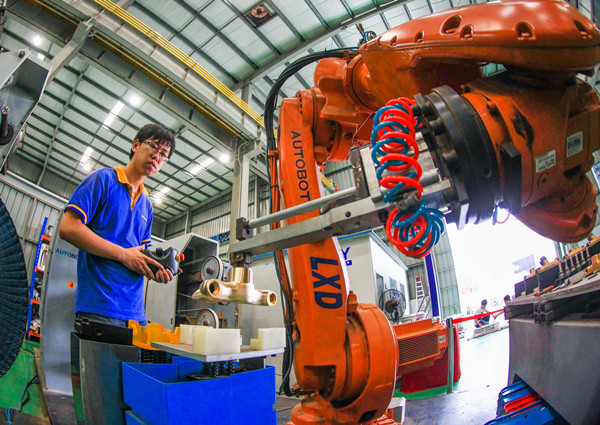Rating bias and spillover impact
 |
|
A worker assembles a robotic arm at a factory in Foshan, Guangdong province. [Provided to China Daily] |
On May 24, Moody's downgraded China's sovereign credit rating to A1 from Aa3. From the reasons given for the downgrade, we see that the international rating agencies still hold hackneyed prejudices against China's economy, exaggerating Chinese government debt risk and misunderstanding the implementation of China's supply-side reform. This ignorance of the actual circumstances of China's economy is the cause of this rating bias. Since the outbreak of the last financial crisis, China has been the anchor of the global economy and has provided the public goods for countercyclical global governance.
Therefore, while such rating bias has a limited impact on China's economy, it is likely to have a spillover effect on various levels, increase procyclical global economic volatility and weigh on the medium to long-term global economic recovery. As such, we believe, amid the global tug-of-war chaos, international rating agencies' rating bias and the spillover effects will become commonplace. China could ease the continuous negative impact with a long-standing effective expectation management mechanism to refuel the momentum for the long cycle recovery of China's and the global economy.
Rating bias stems from hackneyed prejudices. The big three international rating agencies recently downgraded China's sovereign credit rating for the first time since 1999, harping on the same old tune of the high level of government debt, the slow progress of reform, slowing growth, etc. These prejudices and international rating agencies' chase for interest result in the dislocation of analysis from the actual circumstances of China's economy and the misunderstanding of China's policy implementation, hence the serious rating bias:
1) Hackneyed prejudices exaggerate Chinese government debt risk. On the risk front, despite some increase of Chinese government debt in recent years, the debt-to-GDP ratio remains low, which offers ample wiggle room for policy maneuvering and comparative advantages. According to the International Monetary Fund's estimations, China's debt-to-GDP ratio will reach 52% in 2018, which falls below the 60% threshold of the European Union and is significantly lower than that of advanced countries such as Japan, the United States, Germany, France and the United Kingdom for the same period. On the risk control front, unlike the "small government" of Europe and the US, China is a sizable economy and government authorities at all levels hold adequate realizable assets so that they actually have higher debt servicing capability. Moreover, academically, economic growth is the key to resolving the government debt issue. Currently China has much higher economic growth than advanced countries' and the absolute level of 10-year government bond yield. This not only promotes the stable growth of China's fiscal income but also increases the Chinese government's tolerance of even greater financing cost hikes. This makes Chinese debt defaults even more unlikely. Therefore, imposing the criteria in assessing European and US government debt risk on China without due regard to the above differences, will inevitably overestimate Chinese government debt risk.
2) Hackneyed prejudices cause misinterpretation of China's supply-side reform implementation. Firstly, international rating agencies misunderstand China's policy coordination. Ten years since the outbreak of the financial crisis, traditional demand-side stimulus has almost reached a bottleneck. Global economic structural issues need to be dealt with in earnest. Therefore, China first undertook supply-side reform to invigorate total factor productivity and to refuel momentum for long cycle economic recovery. Fiscal stimulus is only used to boost demand in a measured manner to create a stable economic environment and ample room for corporate profit growth, so as to facilitate capacity reduction, destocking, deleveraging, cost reduction and the improvement of underdeveloped areas. Therefore, the increase of debt is modest in speed and amount. Constrained by the traditional policy framework, international rating agencies still see China's policy innovation as the aggressive fiscal stimulus of the likes of the US and Japan and hence drew the flawed conclusion that China's debt will continue to grow.
Secondly, international rating agencies misjudged China's progress in supply-side reform. Following the logic of supply-side reform, the plan for capacity reduction, destocking, deleveraging, cost reduction and improving underdeveloped areas was launched first. This has exposed the cost and created short-term pain in the early stage of reform. However, in the short term, with well-planned policy coordination, China's economy has staged a strong rebound since last year and effectively alleviated short-term pain. In the longer term, the plan for capacity reduction, destocking, deleveraging, cost reduction and improving underdeveloped areas has achieved concrete results. Reform dividends will emerge gradually and facilitate China's economic gear change. Due to their focus on the short-term pain and overlooking of the long-term dividends, international rating agencies have underestimated the medium to long-term growth momentum generated by supply-side reform. Such a misjudgment already took place last year. In March 2016, Moody's and Standard & Poor's cut China's debt rating outlook. But since then, China's economy has become stronger rather than weaker. In the last five IMF projections, China's growth outlook was revised up four times and was left unchanged one time, significantly outperforming other major economies.
Rating bias causes spillover effects. Since the financial crisis, China has become the anchor of the global economy and has provided the public goods for countercyclical global governance. International rating agencies' rating bias has a limited impact on China's fundamentally robust economy, but is likely to cause spillover effects on various levels, increase procyclical global economic volatility and weigh on the global economic recovery.
1) China's economy contributes countercyclical factors to the global economy. Amid the global macroeconomic chaotic era, the global economic recovery has long been weak. Economic globalization is rolling back with the interplay of economic and political risks. China has proactively taken on the responsibility as a great power and provided the public goods for global governance. This has reduced the procyclical volatility of the global economy in three ways: I) China has been pushing forward the transformation of global governance and the stabilization of the global economy with the US. China has been exporting its economic stability to the world through the global value chain, hence facilitating the recovery of global trade and investment; II) overcoming the global governance predicament through the Belt and Road Initiative. Through "interconnection and intercommunication" and international cooperation on production capacity, the Belt and Road Initiative is speeding up factor flow and regional integration is resolving the structural conflict between the economies involved, starting the new wave of global diversification to achieve economic rebalancing; and III) China is proposing and implementing "building together through consultation to share benefits" in managing global order. The beggar-thy-neighbor style zero-sum game is being gradually replaced with this new concept to strengthen policy coordination between countries, thereby resisting the effects of populism, protectionism and isolationism.
2) Rating bias escalates global procyclical risk. History tells us international rating agencies tend to be procyclical in their rating revisions. This not only fails to forewarn of risk but will also stir up market fear and amplify cyclical volatility. The big three international rating agencies have already been criticized for this during the euro debt crisis. The latest cut of China's credit rating is also very procyclical and damages the countercyclical efforts of China and other countries. This further increases the uncertainty of the global economic recovery.
Firstly, given the systemic importance of China's economy, smearing it will seriously impact the growth expectations of many countries and dampen the global economic recovery. According to the IMF's research[1], for every 1 percentage point drop in China's GDP growth, global growth will lose 0.23 percentage points in the near term and the Asia Pacific region (excluding India) will lose 0.06-017 percentage points in growth.
Secondly, the downgrade of China's sovereign credit rating will increase overseas financing costs for Chinese companies. This somewhat obstructs Chinese companies' going abroad plans and limits their ability to help invigorate and stabilize the economies along the Belt and Road.
Lastly, international rating agencies put aside the greater good for their own interest, ignoring the real economic circumstances of China and other emerging markets, and artificially disrupting the natural capital flow with rating difference. This will shake countries' cooperation incentive during a crisis era and resume the old beggar-thy-neighbor style international exploitation, thereby escalating global political and economic conflict and turmoil.
Expectation management eases negative impact. For China's economy, the negative effects of rating bias are mainly caused by expectation manipulation: increasing efforts to cast doubt on China's economy so as to influence domestic and foreign capital flow and to weaken capital support for China's economic restructuring and upgrading. Since crushing the RMB depreciation fear in the beginning of this year, the Chinese government has found a way to effectively manage expectations. After the latest rating downgrade, the relevant authorities swiftly carried out thorough communication with the market. Since then, there has been no unusual volatility of government bond yields and the RMB exchange rate, which correlate to China's domestic and foreign debt servicing capacity. Market expectations have been correctly guided.
It is worth noting that amid the global tug-of-war chaos, international rating agencies' rating bias and the spillover effects will become commonplace. To support the stable recovery of the domestic and global economy, China has to take on its responsibility as a great international power and to ease the continuous negative impact with a long-standing effective expectation management mechanism. Firstly, it is about strengthening its leadership in global governance.
Facing external challenges, China has to participate more deeply in international financial governance and use its economic power to influence the international community to set rules and order, while strengthening the business power and international status of Chinese rating agencies, thereby reducing the over-reliance on international rating agencies. Secondly, China has to optimize the government-market information exchange mechanism, helping the market to get across China's policy arrangement and supply-side reform progress, and pushing for more transparent communication to rectify information asymmetry, hence easing external selling pressure and strengthening positive market expectations for China's economy.
The author is head of research at ICBC International Research Limited in Hong Kong.
- Moody's downgrade not to constitute major impact on China: China, US experts
- Moody's subjective analysis goes awry
- Hard to know Moody's mood
- Experts say Moody's downgrading of China's credit rating shows miscalculations
- Moody's remains confident in outlook
- Moody's sees stable property market, but challenges ahead
- Chinese banks face profitability pressure: Moody's






















